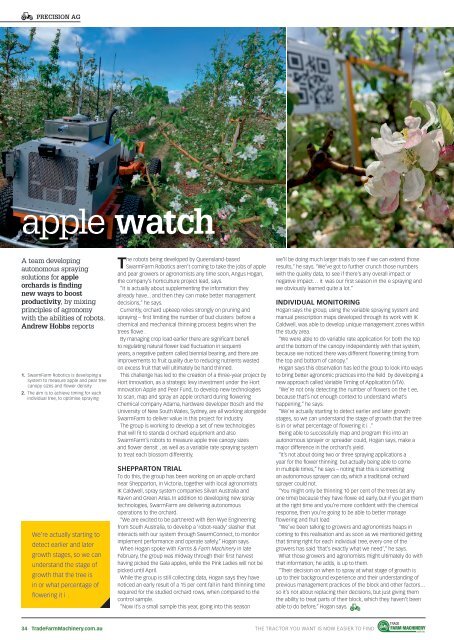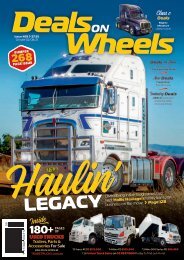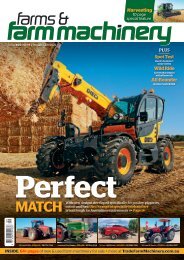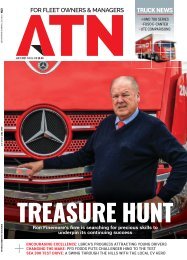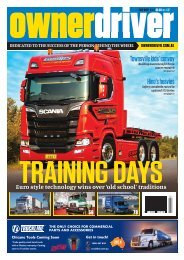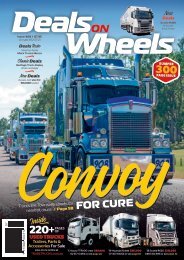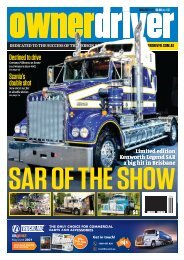You also want an ePaper? Increase the reach of your titles
YUMPU automatically turns print PDFs into web optimized ePapers that Google loves.
PRECISION AG<br />
apple watch<br />
A team developing<br />
autonomous spraying<br />
solutions for apple<br />
orchards is finding<br />
new ways to boost<br />
productivity, by mixing<br />
principles of agronomy<br />
with the abilities of robots.<br />
Andrew Hobbs reports<br />
1. Swarm<strong>Farm</strong> Robotics is developing a<br />
system to measure apple and pear tree<br />
canopy sizes and flower density<br />
2. The aim is to achieve timing for each<br />
individual tree, to optimise spraying<br />
We’re actually starting to<br />
detect earlier and later<br />
growth stages, so we can<br />
understand the stage of<br />
growth that the tree is<br />
in or what percentage of<br />
flowering it i .<br />
The robots being developed by Queensland-based<br />
Swarm<strong>Farm</strong> Robotics aren’t coming to take the jobs of apple<br />
and pear growers or agronomists any time soon, Angus Hogan,<br />
the company’s horticulture project lead, says.<br />
“It is actually about supplementing the information they<br />
already have... and then they can make better management<br />
decisions,” he says.<br />
Currently, orchard upkeep relies strongly on pruning and<br />
spraying – first limiting the number of bud clusters before a<br />
chemical and mechanical thinning process begins when the<br />
trees flowe .<br />
By managing crop load earlier there are significant benefi<br />
to regulating natural flower load fluctuation in sequenti<br />
years, a negative pattern called biennial bearing, and there are<br />
improvements to fruit quality due to reducing nutrients wasted<br />
on excess fruit that will ultimately be hand thinned.<br />
This challenge has led to the creation of a three-year project by<br />
Hort Innovation, as a strategic levy investment under the Hort<br />
Innovation Apple and Pear Fund, to develop new technologies<br />
to scan, map and spray an apple orchard during flowering<br />
Chemical company Adama, hardware developer Bosch and the<br />
University of New South Wales, Sydney, are all working alongside<br />
Swarm<strong>Farm</strong> to deliver value in this project for industry.<br />
The group is working to develop a set of new technologies<br />
that will fit to standa d orchard equipment and also<br />
Swarm<strong>Farm</strong>’s robots to measure apple tree canopy sizes<br />
and flower densit , as well as a variable rate spraying system<br />
to treat each blossom differently.<br />
SHEPPARTON TRIAL<br />
To do this, the group has been working on an apple orchard<br />
near Shepparton, in Victoria, together with local agronomists<br />
IK Caldwell, spray system companies Silvan Australia and<br />
Raven and Green Atlas. In addition to developing new spray<br />
technologies, Swarm<strong>Farm</strong> are delivering autonomous<br />
operations to the orchard.<br />
“We are excited to be partnered with Ben Wye Engineering<br />
from South Australia, to develop a ‘robot-ready’ slasher that<br />
interacts with our system through SwarmConnect, to monitor<br />
implement performance and operate safely,” Hogan says.<br />
When Hogan spoke with <strong><strong>Farm</strong>s</strong> & <strong>Farm</strong> <strong>Machinery</strong> in late<br />
February, the group was midway through their first harvest<br />
having picked the Gala apples, while the Pink Ladies will not be<br />
picked until April.<br />
While the group is still collecting data, Hogan says they have<br />
noticed an early result of a 15 per cent fall in hand thinning time<br />
required for the studied orchard rows, when compared to the<br />
control sample.<br />
“Now it’s a small sample this year, going into this season<br />
we’ll be doing much larger trials to see if we can extend those<br />
results,” he says. “We’ve got to further crunch those numbers<br />
with the quality data, to see if there’s any overall impact or<br />
negative impact… it was our first season in the e spraying and<br />
we obviously learned quite a lot.”<br />
INDIVIDUAL MONITORING<br />
Hogan says the group, using the variable spraying system and<br />
manual prescription maps developed through its work with IK<br />
Caldwell, was able to develop unique management zones within<br />
the study area.<br />
“We were able to do variable rate application for both the top<br />
and the bottom of the canopy independently with that system,<br />
because we noticed there was different flowering timing from<br />
the top and bottom of canopy.”<br />
Hogan says this observation has led the group to look into ways<br />
to bring better agronomic practices into the field by developing a<br />
new approach called Variable Timing of Application (VTA).<br />
“We’re not only detecting the number of flowers on the t ee,<br />
because that’s not enough context to understand what’s<br />
happening,” he says.<br />
“We’re actually starting to detect earlier and later growth<br />
stages, so we can understand the stage of growth that the tree<br />
is in or what percentage of flowering it i .”<br />
Being able to successfully map and program this into an<br />
autonomous sprayer or spreader could, Hogan says, make a<br />
major difference in the orchard’s yield.<br />
“It’s not about doing two or three spraying applications a<br />
year for the flower thinning but actually being able to come<br />
in multiple times,” he says – noting that this is something<br />
an autonomous sprayer can do, which a traditional orchard<br />
sprayer could not.<br />
“You might only be thinning 10 per cent of the trees (at any<br />
one time) because they have flowe ed early, but if you get them<br />
at the right time and you’re more confident with the chemical<br />
response, then you’re going to be able to better manage<br />
flowering and fruit load<br />
“We’ve been talking to growers and agronomists heaps in<br />
coming to this realisation and as soon as we mentioned getting<br />
that timing right for each individual tree, every one of the<br />
growers has said ‘that’s exactly what we need’,” he says.<br />
What those growers and agronomists might ultimately do with<br />
that information, he adds, is up to them.<br />
“Their decision on when to spray at what stage of growth is<br />
up to their background experience and their understanding of<br />
previous management practices of the block and other factors…<br />
so it’s not about replacing their decisions, but just giving them<br />
the ability to treat parts of their block, which they haven’t been<br />
able to do before,” Hogan says.<br />
34 Trade<strong>Farm</strong><strong>Machinery</strong>.com.au THE TRACTOR YOU WANT IS NOW EASIER TO FIND


